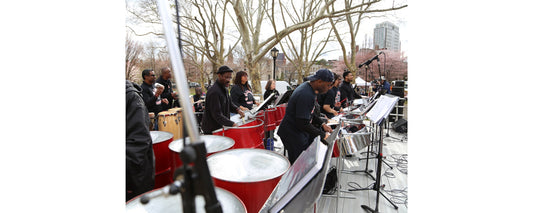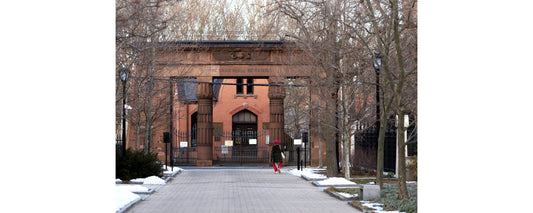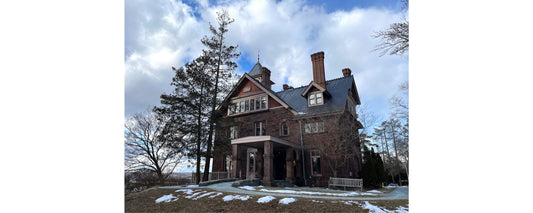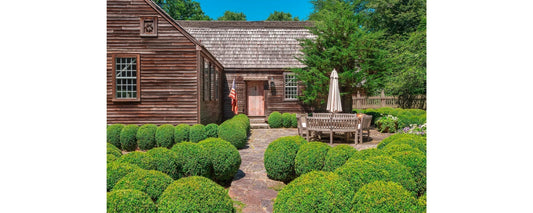Did you know that humans have been tapping sugar maples to make syrup for at least 8,000 years? Or that sap is 98% water? Generations of Hamden fourth-graders have learned these and lots of other facts about maple sugaring thanks to Brooksvale Park (map), where, every February, the sugar shack is steaming and the taps are dripping.
Upwards of 10,000 fourth-graders have visited the sugar shack over the past couple of decades, Brooksvale park ranger Vinny Lavorgna says. Ask most any Hamdenite of a certain age range and they’ll tell you about it. But the shack isn’t just for kids. Anyone can stop by during an open house on March 18 to buy some park-made syrup and learn how to identify a sugar maple, how a hydrometer works and how to know when the syrup’s ready.
The day I visited Brooksvale, off Route 10 in north Hamden bordering the Naugatuck State Forest, the forecast called for temps in the 50s after a night below freezing—just the right weather for collecting sap. But at 10 o’clock in the morning it didn’t feel even close to 50 in the “sugar bush”—the grove of sugar maples—above Brooksvale’s big red barn. It was a morning to keep your hat down and your collar up, hands in pockets. The ground was snowless and soft, the sky gray, the bare trees louvering up and over the hill. Shepherd Glen Elementary School students wandered among those trees with colorful measuring tapes, figuring out the circumference of trunks and, using the formula Brooksvale sugar maker Pete Laffin has just taught them, looking for trees big enough to tap.
sponsored by
They were excited about the biggest tree they found, but Laffin asked them to look at the bark—was it smooth and gray like the sugar maple? No, the kids agreed. “What kind of tree are you?” Laffin asked, putting his ear to the scaly bark as if the tree will tell him. “Oak!” he announced. A few kids registered their dismay.
“I can tap an oak tree,” Laffin told them. “I can get sap from an oak tree. I can tap any tree and get sap from it, depending on what I want to use it for.” Oak sap works as a preservative, he said. Pine sap makes “the best—100%, will never break—glue you can possibly make.” But maples are the best for making syrup, especially sugar maples.
We were standing in one of six sugar bushes in the park. One other was tapped, and four were resting. This was the only one with sap still collected the “old-fashioned” way, using steel buckets catching the drip from steel taps. Taps manufactured today are made of recycled polycarbonate plastic with check valves that prevent germs, mold, bugs and other hazards from entering the tree. Tubes ran from the taps into collection “buckets,” more like large water jugs, also made of plastic.
If you want to tap a tree the original way of the native peoples of Connecticut, Lavorgna says, you’ll hollow out a stub cut from a staghorn sumac branch. Earlier that morning, he gave each child a piece of staghorn sumac, and they tried their hands at hollowing it out with a metal tool made from a clothes hanger. The resulting wooden taps were souvenirs to take home, and I wondered how many of these 10,000 hollowed bits of wood are still stashed in kids’ bedrooms and old coat pockets all over town.
The Quinnipiac and other early peoples evaporated water from the sap they collected in a wooden trough by adding very hot stones to the liquid, causing it to boil and steam, Lavorgna told the kids. Then Laffin walked us down to the red sugar shack next to the barn, where more modern methods were at work. Smoke drifted from the shack’s little chimney, and, through its large open windows, we leaned in to watch Laffin feed the fire with some wood we picked up along the way, then pour a bucket of sap into the evaporator’s reservoir pan. It takes 40 gallons of sap to make just one gallon of syrup, and the evaporator must be watched constantly because you never know when the syrup will be ready. That was the job of Laffin and barnyard manager Amy Kulikowski, who’d been manning the shack all morning.
Syrup-makers use all their senses to decide when the syrup is ready, Laffin told the kids. They watched for the color to turn from clear and watery to amber and the steam to dissipate as the water evaporated. They smelled its sweetness. They listened for the sound of a vigorous boil. In the meantime, we heard what Laffin called a “nice, gentle boil like I’m making spaghetti.” He drummed his hands on the pan to tell us what it will sound like when the syrup, which boils at 219 degrees, is almost ready. A hydrometer measures the water content and a thermometer the temperature, and then, of course, there’s the “distinctive taste” of the maple syrup.
As the fourth-graders and their teacher headed back up the driveway to meet their bus, Kulikowski slid the sugar shack windows closed to retain the heat. It’s a damp, dark job tending the evaporator, but both she and Laffin seemed to love what they were doing. And it wouldn’t be a job for much longer. Maple sugar season lasts just a handful of weeks each year. The shortest season Lavorgna recalls was only three weeks long. In a good year, it’ll be six or seven.
The day was finally warming as Laffin and I headed up the hill, too. There was a promise of sun in the sky and the promise of maple syrup, available once more just a couple weeks from now, straight from the Brooksvale woods.
Brooksvale Park
524 Brooksvale Ave, Hamden (map)
Maple Sugar Day: March 18, 10am-2pm
(203) 287-2669
www.brooksvalepark.com
Written and photographed by Kathy Leonard Czepiel. This updated story was originally published on March 1, 2018.








